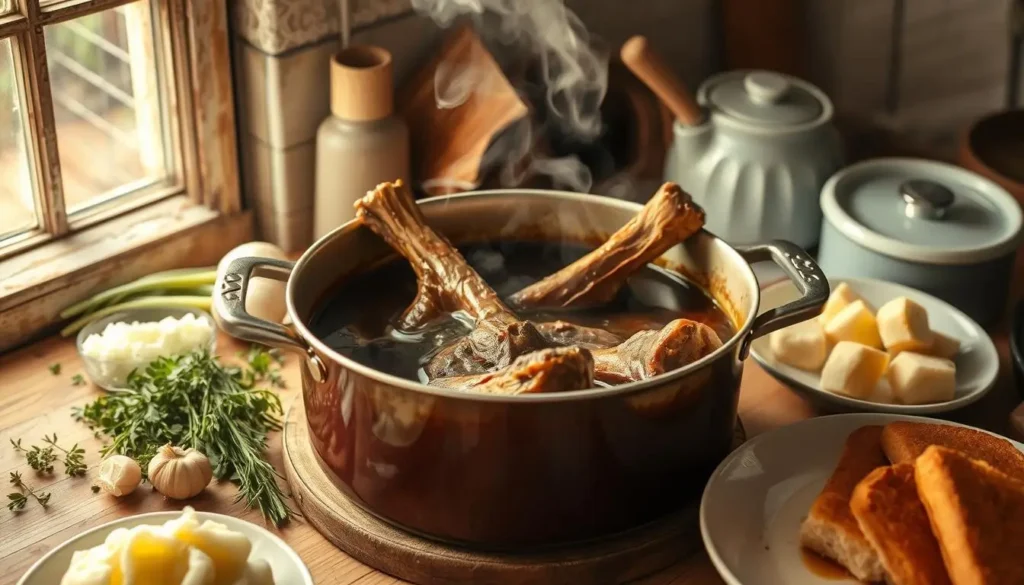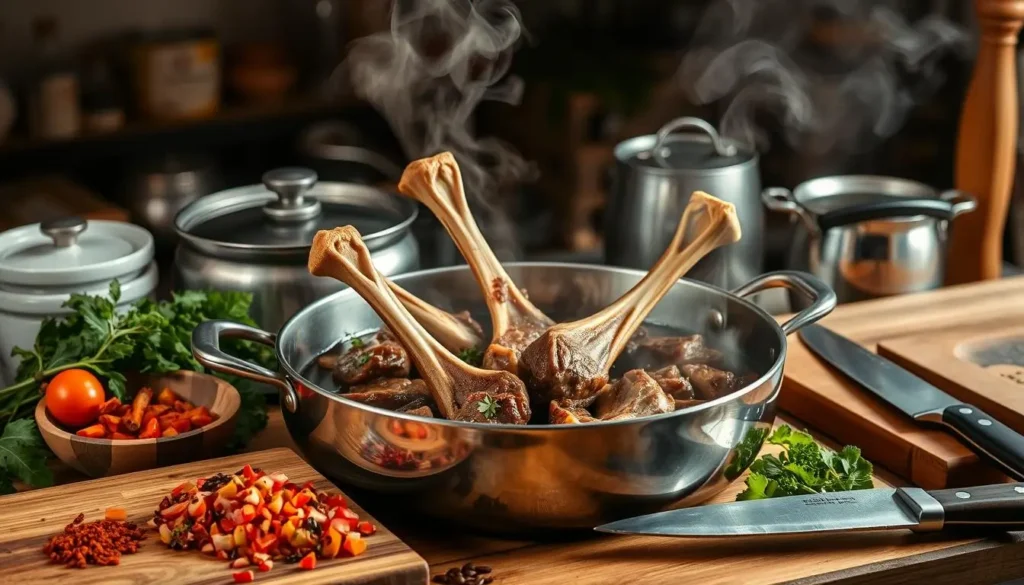Discover the best beef neck bones recipes for hearty, flavorful meals your family will love.
Growing up in a Southern kitchen, I learned that the most delicious meals often come from unexpected ingredients. Beef neck bones, a true hidden gem of soul food, made our family dinners unforgettable. They brought everyone together around the table.
These affordable and flavorful beef neck bones recipes will change your home cooking. They offer rich, deep flavors and tender meat that falls off the bone. This makes them a budget-friendly way to create dishes that impress your family.
Whether you’re a seasoned home cook or new to soul food, these recipes will be your favorite. They’re perfect for hearty, comforting meals that celebrate tradition and taste. Get ready to unlock the secrets of turning this humble cut into a culinary masterpiece.
Table of Contents
Key Takeaways
- beef neck recipes are an affordable and delicious soul food staple
- Slow cooking methods create incredibly tender and flavorful meat
- Perfect for budget-conscious families seeking rich, satisfying meals
- Versatile ingredient that works with multiple cooking techniques
- Packed with protein and collagen for nutritious meals
Understanding Soul Food’s Hidden Gem: Beef Neck Bones
beef neck recipes are a key ingredient in soul food, rich in cultural history and flavor. Once seen as cheap, they’ve become a beloved part of many family meals.
The Cultural Significance of Neck Bones
Soul food traditions hold beef neck recipes in high esteem. They symbolize the ability to make delicious meals with little. Your beef neck bones soup recipe connects you to a long line of cooks.
“Neck bones tell a story of survival, resilience, and transforming simple ingredients into extraordinary meals.” – Chef Marcus Johnson
Nutritional Benefits and Value
Learning to cook beef neck recipes reveals their nutritional value. They are full of important nutrients:
- High protein content
- Rich in calcium
- Abundant collagen for joint health
- Budget-friendly protein source
| Nutrient | Amount per Serving |
|---|---|
| Protein | 14g |
| Calcium | 47mg |
| Fat | 4g |
Why Choose This Cut for Your Family Meals
beef neck recipes are more than just food. Their unique texture and ability to create rich, gelatinous broths make them ideal for soups and stews. With the right cooking, they become tender and full of flavor, pleasing everyone at the table.
Essential Ingredients and Equipment for Perfect Results
To make an easy beef neck bones recipe, you need the right ingredients and tools. Start by knowing the key parts that make neck bones into a tasty stew.
Key Ingredients
- Beef Neck Bones: 2-3 pounds of high-quality bones
- Aromatic Vegetables:
- 1 large onion, chopped
- 4 garlic cloves, minced
- 2 carrots, chopped
- 2 celery stalks, diced
- Flavor Enhancers:
- 1 cup red wine
- 2 cups beef stock
- 2 tablespoons tomato paste
Essential Seasonings
| Spice | Quantity |
|---|---|
| Salt | 2 teaspoons |
| Black Pepper | 1 teaspoon |
| Smoked Paprika | 1 tablespoon |
| Allspice | 1/2 teaspoon |
Recommended Cooking Equipment
- Dutch Oven or heavy-duty oven-proof pot
- Wooden Spoon
- Tongs
- Large Skillet
- Fork
Pro Tip: The key to a perfect beef neck recipes stew is patience and low, slow cooking to ensure tender, flavorful meat.
By choosing quality ingredients and the right tools, you can make a dish that will wow your loved ones.
Mastering the Art of Selecting and Preparing Beef Neck Bones
Choosing and preparing beef neck recipes is key for tasty recipes. It’s all about picking the right cut and preparing it right. This ensures your dish is full of flavor and tender.
- Look for bones with fresh, pink-colored meat
- Seek cuts with visible marbling for enhanced flavor
- Choose bones from reputable butchers or grocery stores
- Check for clean, uniform appearance
Choosing Quality Cuts
Quality beef neck bones are essential for tasty dishes. Make sure the meat is:
| Characteristic | Ideal Condition |
|---|---|
| Color | Bright pink to light red |
| Fat Marbling | Moderate, white streaks |
| Smell | Fresh, neutral odor |
Proper Cleaning Techniques
Cleaning beef neck bones is crucial. Follow these steps:
- Rinse bones under cool running water
- Pat dry with clean paper towels
- Trim excess fat if desired
- Remove any visible bone fragments
Initial Preparation Steps
Before cooking, season your beef neck bones well. A simple seasoning blend can make a big difference:
“The secret to great beef neck bones is in the preparation and seasoning.”
- Use 2 tablespoons kosher salt
- Add 1 tablespoon black pepper
- Sprinkle 1 teaspoon garlic powder
- Include 1/2 teaspoon dried thyme
Pro tip: Always let the meat come to room temperature before cooking. This helps with even heat and tenderness.
Classic Beef Neck Bones Recipes for Memorable Meals
Discover the magic of turning beef neck bones into delicious dishes that will wow your family. The best recipe uses affordable ingredients and slow cooking to make tender, tasty meals. These dishes warm both body and soul.
When making a beef neck bones stew, focus on techniques that boost flavor and tenderness. The low-and-slow cooking method breaks down collagen. This makes your meat fall off the bone.
“Cooking neck bones is an art that transforms an economical cut into a culinary masterpiece.” – Southern Cooking Experts
Classic Beef Neck Bones Stew Recipe
- Prep Time: 10 minutes
- Cook Time: 6 hours
- Total Time: 6 hours 10 minutes
- Servings: 4 people
Ingredients
- 3 pounds beef neck bones
- 1 large onion, chopped
- 2 medium carrots, diced
- 2 celery stalks, sliced
- 6 cups low-sodium chicken broth
- Seasonings to taste
Cooking Instructions
- Brown neck bones in a hot skillet
- Add vegetables and broth
- Simmer at 275-325°F for 2 hours
- Check tenderness every 15-20 minutes
| Nutritional Information (per serving) | Amount |
|---|---|
| Calories | 423 kcal |
| Protein | 22 g |
| Carbohydrates | 31 g |
| Fat | 14 g |
Pro tip: For maximum flavor, consider using pomegranate juice as a braising liquid alternative to red wine. This technique adds depth while keeping the recipe versatile for different dietary preferences.
Slow Cooker Methods for Tender, Flavorful Results
Turning beef neck bones into a delicious meal is easy with your slow cooker. The crockpot method makes the meat tender and full of flavor, so it just falls off the bone.
Slow cooking makes it simple to make amazing dishes. Your slow cooker beef neck bones will get deep, rich flavors from cooking low and slow.
Braising Techniques for Perfect Texture
Temperature and Timing Guidelines
Enhancing Flavor with Aromatics and Vegetables
“The magic of slow cooking is transforming tough cuts into tender, flavorful masterpieces.” – Culinary Experts
Creating Rich and Savory Gravy from Neck Bones

“The secret to an incredible gravy is patience and layering flavors during the cooking process.” – Southern Cooking Expert
Perfect Side Dish Pairings for Your Beef Neck Bones
Traditional Soul Food Companions
Modern Culinary Twists
“The right side dish can turn a simple meal into a memorable dining experience.” – Southern Cooking Tradition
Tips for Achieving Restaurant-Quality Results at Home

“Great cooking is about technique, not just ingredients” – Professional Chef Wisdom
Storage and Reheating Guidelines for Leftovers
Optimal Storage Practices
Reheating Techniques
“Preserving the rich flavors of your beef neck bones is an art of careful storage and gentle reheating.” – Home Cooking Expert
Conclusion
The art of cooking beef neck bones is more than just following a recipe. It’s about connecting with our culinary past, enjoying nutritious food, and saving money. With 22g of protein and minerals like iron and zinc, these bones are a treasure trove of health and taste.
Whether you’re making stock for hours or using the air fryer, beef neck bones offer endless possibilities. Your skills can turn these simple ingredients into dishes that impress and delight. It’s a chance to show off your creativity and respect for different cultures.
We encourage you to keep exploring and sharing your beef neck bones recipes. Every meal is a chance to learn, create, and bond over delicious food. It’s a universal language that brings people together.
FAQ
What are beef neck bones and why are they popular in soul food?
Beef neck bones are a tasty, affordable cut of meat loved in soul food. They’re full of collagen, making dishes rich and satisfying. Slow-cooked, they become tender and flavorful.
How long does it take to cook beef neck bones?
Cooking beef neck bones takes 2-4 hours, depending on the method. In a slow cooker, they need 6-8 hours on low. Braising in a Dutch oven takes about 2-3 hours at a low temperature.
Are beef neck bones nutritious?
Yes, they’re very nutritious. Rich in protein and collagen, they also have calcium and phosphorus. Plus, they’re easy on the wallet, making them great for family meals.
What are the best cooking methods for beef neck bones?
The top methods are slow cooking, braising, and stewing. These break down tough tissues, making the meat tender and flavorful. Slow cookers and Dutch ovens are best for this.
How do I select quality beef neck bones?
Choose bones that are fresh and have a pink-red color. Look for some marbling for more flavor. Avoid bones with brown or gray spots. Buy from a trusted butcher or meat department.
Can I freeze beef neck bones?
Yes, you can freeze them raw for 4-6 months or cooked for 2-3 months. Keep them in airtight containers or bags to prevent freezer burn.
What are some classic side dishes to serve with beef neck bones?
Serve them with soul food favorites like collard greens, black-eyed peas, mashed potatoes, and cornbread. These sides enhance the meat’s rich flavor, making a complete meal.
How can I make beef neck bones more tender?
Use low and slow cooking to make them tender. Browning the bones first helps. Adding acidic ingredients and keeping the temperature low also works well.
Are beef neck bones budget-friendly?
Yes, they’re very affordable. Much cheaper than premium cuts, they’re perfect for making delicious meals without spending a lot.
Can I use beef neck bones in different cuisines?
While often used in soul food, they’re versatile. They fit well in Latin American, Asian, and European dishes, adapting to various flavors and cooking styles.

